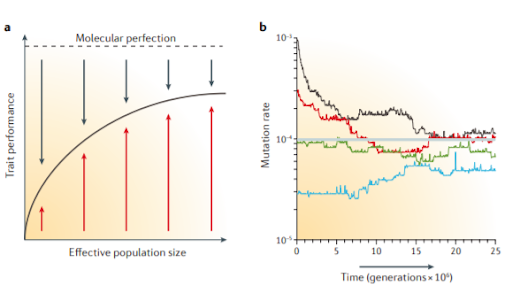Drift-barrier Hypothesis on:
[Wikipedia]
[Google]
[Amazon]
The drift-barrier hypothesis is an ecological hypothesis formulated by Michael Lynch in 2010. It suggests that the perfection of the performance of a trait, in a specific environment, by natural selection will hit a hypothetical barrier. The closer a trait comes to perfection, the smaller the fitness advantages become. Once this barrier is reached, the effects of further beneficial mutations are unlikely to be large enough to overcome the power of random genetic drift. Selection generally favors lower mutation rates due to the associated load of deleterious mutations that come with a high mutation rate.


Description
Every population contains a certain amount ofgenetic variation
Genetic variation is the difference in DNA among individuals or the differences between populations. The multiple sources of genetic variation include mutation and genetic recombination. Mutations are the ultimate sources of genetic variation, b ...
, coding for different functional traits. When the environment in which the population lives changes, some of these traits turn out to be more advantageous for this new situation than others. Through natural selection
Natural selection is the differential survival and reproduction of individuals due to differences in phenotype. It is a key mechanism of evolution, the change in the heritable traits characteristic of a population over generations. Cha ...
and random genetic drift
Genetic drift, also known as allelic drift or the Wright effect, is the change in the frequency of an existing gene variant (allele) in a population due to random chance.
Genetic drift may cause gene variants to disappear completely and there ...
, the traits with a negative effect on population fitness disappear from the gene pool
The gene pool is the set of all genes, or genetic information, in any population, usually of a particular species.
Description
A large gene pool indicates extensive genetic diversity, which is associated with robust populations that can surv ...
. The balance between the influence of natural selection and genetic drift on the population mutation rate is mainly determined by the population size. Large populations are predicted to generally have lower mutation rate
In genetics, the mutation rate is the frequency of new mutations in a single gene or organism over time. Mutation rates are not constant and are not limited to a single type of mutation; there are many different types of mutations. Mutation rates ...
s than smaller populations. Populations containing individuals with high mutation rates are more adaptable to environmental changes. Such populations have a bigger genetic pool, and therefore a bigger chance of containing an advantageous functional trait for this new environment. These advantageous functional traits get fixed in the population due to positive directional selection
In population genetics, directional selection, is a mode of negative natural selection in which an extreme phenotype is favored over other phenotypes, causing the allele frequency to shift over time in the direction of that phenotype. Under ...
. The population keeps fixing these advantageous traits over time, pushing the population towards the genetic perfection associated with the environment. This increasing perfection causes mutations to have a higher chance of being deleterious. Individuals with a high mutation rate now increasingly decrease population fitness, and selection causes the mutation rate to decrease again. At the same time, new advantageous alleles have a diminishing positive effect on fitness. At a certain point, natural selection, mutation rate and random genetic drift reach a balance. This is called the drift-barrier.
Exceptions for the drift-barrier hypothesis
Traverse and Ochman showed a striking exception to the drift-barrier hypothesis.{{Cite journal, last1=Traverse, first1=Charles C., last2=Ochman, first2=Howard, date=2016-03-22, title=Conserved rates and patterns of transcription errors across bacterial growth states and lifestyles, journal=Proceedings of the National Academy of Sciences, language=en, volume=113, issue=12, pages=3311–3316, doi=10.1073/pnas.1525329113, issn=0027-8424, pmid=26884158, pmc=4812759, doi-access=free In 2016, they measured transcriptional error rates in Escherichia coli as well as two endosymbiotic prokaryotes, Buchnera aphidicola and Carsonella ruddii. The endosymbionts had dramatically reduced genome sizes, increased mutation rates, and other features typical of their small population sizes. This included the loss of several transcriptional fidelity factors. Traverse and Ochman’s results showed that the transcriptional error rates between E. coli and the two endosymbionts were nearly equal even though their population sizes were very different. Their initial prediction was that the endosymbionts would have higher transcription error rates as they were subject to a large amount of genetic drift. This would mean that they would therefore sustain more deleterious mutations. However, neither Buchnera aphidicola and Carsonella ruddii had elevated transcription error rates.References